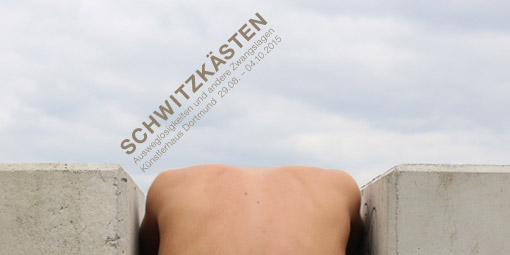
Schwitzkasten literally translated into English means sweatbox. A sweatbox (a.k.a. sauna or torture device) is physically regarded as a rectangular wooden box with hole for the head, used to wash out poisonous substances out of the body. However, in this group show, there are no rectangular wooden boxes to be seen, rather the idea is synonymous for a hopelessness situation, from which to escape. The participating artists rose to the challenge to create works with this in mind.
The idea for this exhibition arose from a found photo of a police officer putting a man into a “Schwitzkasten,” but not a sweatbox! The word Schwitzkasten has another meaning in the German language, namely “headlock.” The man portrayed in the photograph was not able to free himself out of the headlock. From this found photo was born an intensive research into the different meanings of Schwitzkasten. With so many aspects of the different headlocks, it was necessary to bring it all “under the microscope.” There are purely situational aspects of the headlock/sweatbox (Schwitzkasten) can be associated with pure personal emotions or experiences (violence, dominance, personal suppression) or in regards to the rule of law or a global level (military prisons, torture, ecological disasters), as well day to day, in the field of urban development (gentrification).
But also found in the composition of the exhibition are observances of more pure visual aspects of the headlock/sweatbox. Next to installation art, videowork, sculpture, objects and performances, we see also drawings and classical painting positions in the curated exhibition from Jörg Daniel.
Well known fairy tales (Sleepin Beauty) are subject of discussion, as well as dance and theatrical scenes; humans in tortuous poses and suppressed by headlocks.
Please note: Additional works of the participating artists can also be seen at "Projektraum Offene Antworten", Kaiserstr. 75, Dortmund.


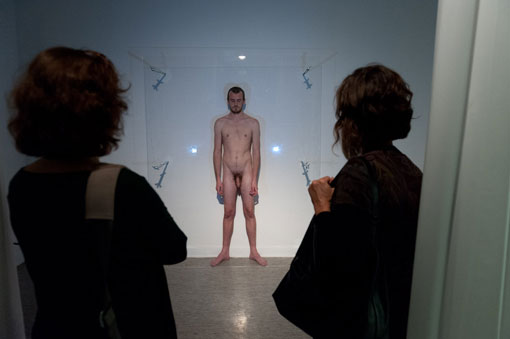
The initial situation of the work „NO EXIT“ by Kurt Fleckenstein is torture in general. “We live in times, in which torture and degradation of humans again reach a new peak. Instead of all ethic and civilisatory achievements the human race isn´t able to ostracize torture. The new „religious wars“, first of all the IS war, lead into exposing human beings extreme and unbelievable pain“. The installation/action NO EXIT by Kurt Fleckenstein, in which a naked man is pressed behind a pain of glass and filmed as well thereby, shall artistically bring the problem of torture in the everyday occurance.
Every Sunday during the opening hours from 16 - 19h the video livestream of the work „no exit“ by Kurt Fleckenstein can be seen on guest:guest1@92.50.83.54.
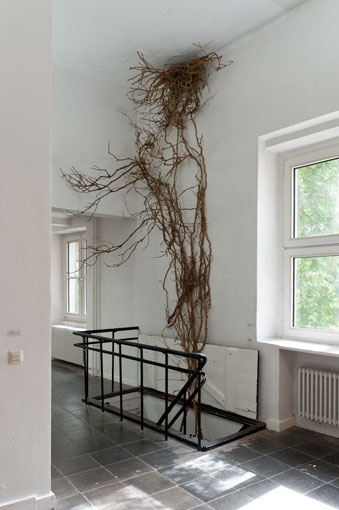
No matter what kind of medium she uses - whether sculpture, photography or video - the Paris based artist Dominique Ghesquiere deals with the illusion of reality. She makes use of trompe - lóeil - the art of visual illusion - and the well-known turns out to be something different. With her installation-like work „Bois Dormant“ the artist brings the climbing plant ivy into the building - but not, however, without slightly changing the regular appearance: she uses real plants, but the usually evergreen climber seems to be limitated in it´s growth this time and rises absolutely bare of leaves - like to be taken into a „headlock“ -, over two storeys. So the focus lies on the strong ivy tendrills with their innumerable holdfast roots, that usually help the plant to climb up high walls. The title of the work is a reference to the well-known fairytale „Sleeping Beauty (in the woods)“ in the french version „La belle au bois dormant“, written by Charles Perrault and first published in 1697.
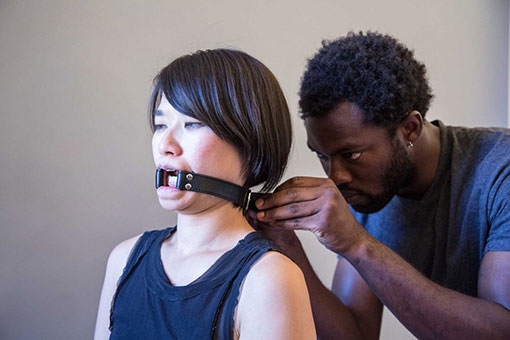
In this brandnew work, until now only presented one time in New York, kate hers RHEE makes use of one of her selfconstructed objects to create this distraught performance between two actors. The thin black male actor seems to dominate the scene and demands from the small asian female actress, that wears a s/m mask, ten kisses, before to liberate her from this bizarre and strange mask. A strong picture of violance, dominance and suppression arises, completed with confusing and depressing gender role and race dynamics.
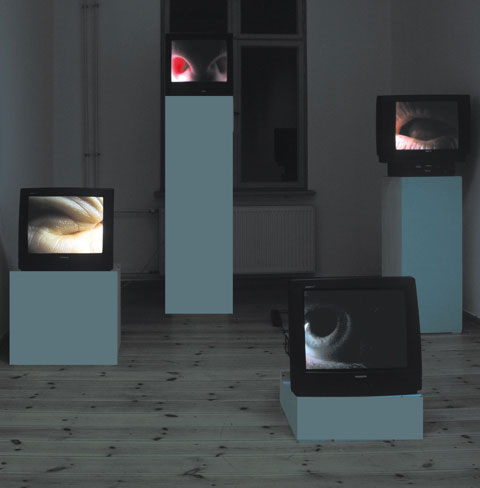
In her artistic work Karin Kerkmann deals with communication- and perceptive processes. Border crossings, intermediate worlds and the suspense between the inner and outer world are the themes of her works. In „come to your senses“ from 2004 she has a good look at the human perception in itself. Can you trust your perception? Does something like an objective perception exist?
„Come to your senses“ is made up of 4 different videos, presented on four screens. The single screens are placed on sockets of different hights and each show one human sense organ as close up. The sense organs „sit“ in their screens like animals in boxes. The nose holes thereby convert to two caves, their nose walls move in irrational manor. The eye seems to arise out of darkness and moves restless from here to there. The skin suggests the spectator mountains and valleys in it´s movement.
„The metamorphosis arises in the view of the spectator. The works move between reality and irrationality, certainty and state of suspense. The attention of Karin Kerkmann lies on the suspense in itself.“
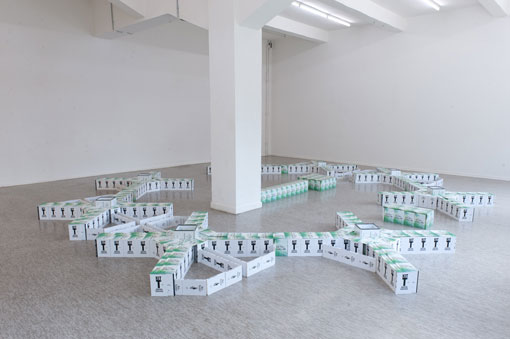
With „Guantanamo“ Kloetgen denounces the abuse and undescribable methods of torture of the US in the military prison of Guantanamo in cuba. The prison „Guantanomo bay navaral base“ can be named as one of the best known and best unknown places at the same time. In this group show at the Künstlerhaus Dortmund a model of the prison will be rebuilded with 1001 books. Performance poet Frank Klötgen therefore uses only his self written three books of poems „Holz und die sieben Todsünden“, „Kitt!“ and „Mehr Kacheln!“ and his oppressive novel „Der Fall Schelling“.
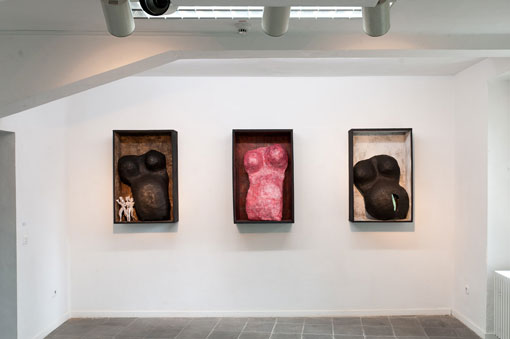
„Instead of being equipped with reason, intellect, knowledge and will the human being again and again maneuvres himself into „Schwitzkaesten (which means headlocks)“, predicaments and other hopelessness situations. The playground of these incidents begins in the private, individual area and ends on a the global base, what in earlier times and nowadays often leads into terrible human, ecologic and economic catastrophies. These contradictions of the human species builds the main theme of this work. 1959 born in Hagen and grown up in Herne / Westfalia the artist Christian Loenhoff studied fine arts and sports in Bochum. Furtheron the award winning artist of the city of Herne has taken part at unnumerous art actions, performances and nationwide exhibitions.
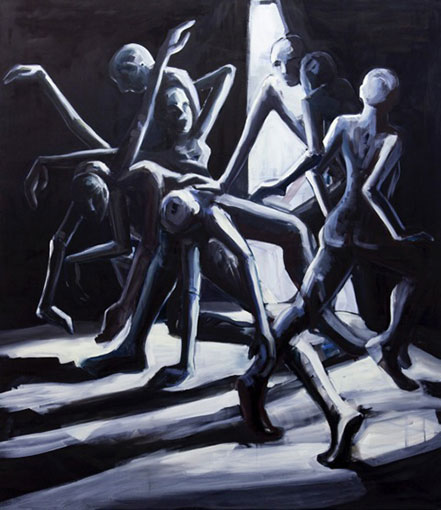
Inspired by the stage - mainly by dance and theatre - Ilona Ottenbreit since years works on composing human expanses and movements. Studies and scetches to that are the base of her partly huge formatted works. Everything begins with charcoal scetches to examine movement and it´s sequences. With a drawn line she then follows dancers and records, what these moments make out. Abstract figurative drawings, merged with charcoal and ink are created. Thereby she tries to emphasize the important and most interesting aspects. Own formats and melting situations of the figures arise. Therewith she demonstrates, how human beings copy themselves, combine or fight with each other, move away into different directions, always not really knowing how to seperate from each other.
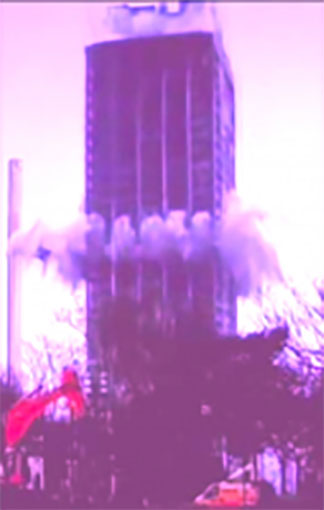
Living in Berlin, the Turkish artist Funda Özgünaydin is going to sensitize the visitors of the exhibition with her video work „outside projection“ for gentrification. Acting for that she shows the demolition of the AFE Building in Frankfurt / Main, a 116 meter high tower of the Goethe-University, which accomodated the faculties educational theory, social sciences and psychology. Completed in 1972 the building was totally vacated in 2013 again and in the end pulled down in 2014.
Gentrification is an applied term, that describes the social restructuring of a district or a part of a town. Thereby it deals with ennoblement of the living quarters as well by changing the population, but also normally by restauration- and alterational works. So, in example for former tenants and artists gentrification describes a kind of a headlock-situation, they cannot get out really. As soon as artists have moved into suitable workspaces to upgrade their sphere, such real estates often and likely are bought by investors, vacated again, restaurated and rented for a much higher price to private or business clients. Fine arts and the artists fall by the wayside.
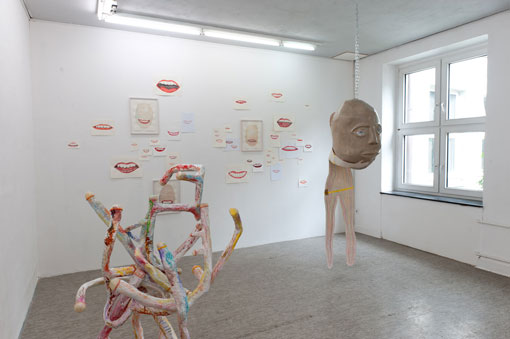
Born in 1958 in Essen, often awarded artist Hildegard Skowasch, also founder member of the Künstlerhaus Dortmund, studied at the academy of arts in Münster and at the Ecole Superieure des Arts Plastiques in Tourcoing (F) and lives and works in Berlin since 1988. In her installation for this group show Hildegard Skowasch combines perfectly abstract and figurative elements in form of paper- and ceramic works, as well as drawings.
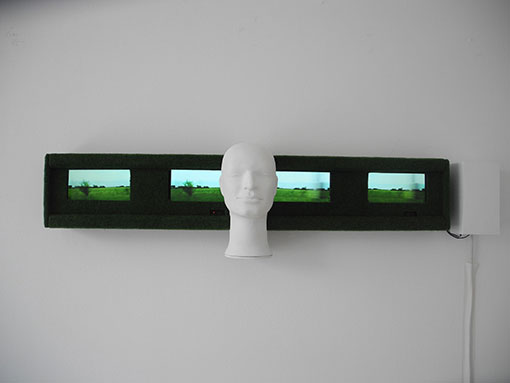
„Funnel“ is a brandnew sculptural video work from 2014/2015 from Berlin based and often awarded artist Margund Smolka, born 1958 in Kiel. The work consists of wood, astroturf, a plastic head and diverse other materials, as well as 4 in the work integrated dvd-players.
Accompanied by the dull roir of a train a green landscape runs - mirrored from right to left coming - endlessly into the head - in the central element of the sculpural video work „Funnel“ from Margund Smolka.